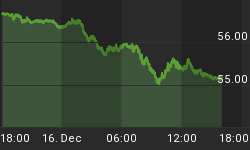Based on the December 2nd, 2013 Oil Investment Update
In our last commentary on oil stocks from Nov. 20, we examined the NYSE Arca Oil Index (XOI) to find out what the current outlook for oil stocks was. In the summary, we wrote that the combination of a strong resistance level (the upper line of the smaller rising wedge) and the position of the RSI may encourage sellers to lock profits and trigger another correction in the coming days.
In the two following days,oil stocks extended their rally and hit a fresh annual high at 1,504. Despite this improvement, they reversed course and the breakout above the major medium-term resistance and psychological barrier at 1,500 was invalidated. On top of that, the oil stock index also invalidated the breakout above the previous 2013 high.
These strong bearish signals encouraged us to examine the oil-stocks-to-oil ratio once again. However, today we'll check this ratio to find out what impact it could have on future oil stocks' moves.
At the beginning, we want to emphasize a strong positive correlation between the ratio and the oil stock index in recent months. When we compare the situation in both cases, we clearly see that the entire Sept.-Nov. rally in the XOI was in perfect tune with the ratio's rally. Please note that in 2012 and also at the beginning of 2013, higher values of the ratio didn't correspond to the price action in the oil socks index as precisely as they do now (we marked these cases with green rectangles on the weekly chart). If this strong positive relationship between the XOI and the ratio remains in place, we can find interesting tips analyzing the charts below. Let's start with the long-term chart (charts courtesy by http://stockcharts.com).

Looking at the above chart, we see that the ratio reached the 38.2% Fibonacci retracement level (based on the entire 2009-2011 decline). As you can see, there was a small breakout above this strong resistance level, but it was invalidated, which is a bearish signal. Additionally, the ratio still remains in the gap between the April 2009 low and May 2009 high (marked with the red rectangle), which is not supporting further growth. From this perspective, the implications for oil stocks are bearish.
Now, let's zoom in on our picture and examine the weekly chart.

The first thing that catches the eye on the above chart is an invalidation of the breakout above the resistance level created by the September 2009 high, which is slightly below the 38.2% Fibonacci retracement (marked on the previous chart). An invalidation by itself is a bearish signal, which, in combination with the position of the RSI, suggests further deterioration in the ratio.
When we factor in the position of the CCI, we clearly see that the indicator is extremely overbought. On top of that, there is a negative divergence between this indicator and the recent upswing in ratio, which is another bearish signal. From this perspective, the implications for the oil stock index are also bearish.
Now, let's check the short-term outlook.

Looking at the above chart, we see that last week the ratio moved higher and broke above the previous high. With this upward move, the ratio broke above the medium-term rising resistance line based on the November 2012 and May 2013 highs (marked with the red line). However, the breakout was invalidated, which does not bode well for the ratio.
Additionally, we clearly see a deepening divergence between the RSI and the ratio. At this point it's worth noting that a similar divergence between the RSI and the XOI triggered a correction in the previous week in the oil stock index. Therefore, taking into account the strong positive correlation between the ratio and oil stocks, if the ratio declines in the coming days, the XOI will likely extend its decline.
Summing up, connecting the long-, medium- and the short-term pictures, we clearly see that the ratio reached a strong resistance zone created by the long-, medium- and short-term lines. Although we saw breakouts above them, they all were invalidated. This is a strong negative signal for oil stocks holders, which suggests that further declines are just around the corner.
Thank you.
















